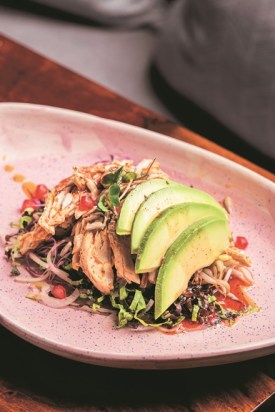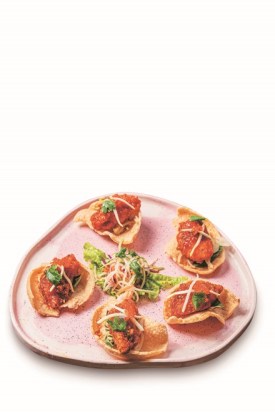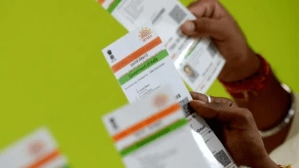On a wet afternoon, perfect for some spicy fare, a crisp samosa sounds perfect. Only, we are headed to Burma Burma for some samosa soup and samosa cheesecake. Light, spicy, hot and comforting, some south-east Asian flavours are just right for the weather. We start with a light lemongrass lentil and banana stem soup that hits the spot right away. Called Mohinga, it is the unofficial national dish of Myanmar. Served with a lentil crisp and sharp flavours, it’s a meal in itself. Burmese cuisine is big on salads, with little emphasis on dairy. Tofu replaces cheese and there is a replacement for tofu too, called tohu, which is soft bites of steamed chickpea flour that are incorporated into stir fries and curries. A salad of semi-ripe guavas tossed with sriracha and crushed peanuts is fresh and flavourful, while lotus stem chips doused in paprika are crisp and spicy.
Rice is the mainstay of Burmese cuisine, with various vegetables and meats accompanying it. Some sticky rice cooked in a mustard broth and edamame goes great with a water chestnut and tofu stir fry.

An udon noodle bowl with coconut curry and charred bok choy is packed with deep flavours, and is deeply satisfying.
Interestingly, the Indian samosa is reincarnated in a smaller Burmese avatar, filled with either meat, vegetables or pistachios, depending on the dish. Savour it in a soup, a samosa salad or a dessert. Neighbourly love at its crispiest best!
Burma has a variety of traditional desserts with sago, coconut, palm jaggery, durian dominating the flavours. Be it a cool panna cotta, a moist semolina cake or a Burmese version of falooda with chilled coconut milk and basil seeds, the meal ends on a very sweet note.
Thai, Vietnamese, Chinese, Korean or Burmese cuisines—all are big on flavourful broths, noodle bowls and crisp spicy snacks. And, with several restaurants offering these specialty cuisines, you can be spoilt for choice.
For instance, at Mamagoto, which offers multiple Asian cuisines, the Thai menu is authentic and extensive. One can start with a delicious bowl of Tom Yum, a sour and spicy soup bursting with flavours of lemongrass and kaffir lemon leaves, is light and filling.
The Som Tam salad is a perennial favourite and the crisp raw papaya and peanut dish is a delicious blend of sour and sweet. “Lemon juice, jaggery, red chilli paste, garlic and soy sauce make for the dressing,” explains area chef Tara Singh Sunar. Coconut is crucial to Thai cuisine, and if looking to experience that, snow peas and green beans salad is a good choice. When talking Thai food, the iconic Pad Thai is a must-try. A rice noodle dish, again a culinary commonality between south-east cuisines, Pad Thai is simply comfort in a bowl, making for a toothsome meal. This quintessential Thai dish exhibits a harmonious blend of flavours, striking a delicate balance between sweet, savoury and tangy. Peanuts and herbs as garnish offer a dash of crunch and aroma. Chef Sunar says it is herbs that “are the most commonly used ingredient in Thai cooking” and offer it its unique identity. Again, for coconut lovers, the Chiang Mai Train Station noodles is a great option.
Rice is a south-east Asian staple, and any food tour is incomplete without it. Hence, we had to try the restaurants’ classic Spicy Bangkok Bowl. Sticky rice and an explosion of flavours in a bowl, filled with an ample amount of spices, garlic and, of course, chillies, the dish sits well for a cool, rainy day. If looking to keep up the spice level, the Fiery Thai shrimp fried rice with Asian green chilli chicken ribbons is what you can try. If averse to this level of spice, the soggy Thai basil fried rice is the option for you.

End the meal on a sweet note of the season’s hot favourite, a simple dessert of sticky rice and mangoes.
Thai and Chinese apart, there are a plethora of restaurants offering cuisines from Vietnam and South Korea too. Viet:Nom, at Cyberhub and Worldmark Gurugram and Goa, offers a refreshing take on Vietnamese cuisine. While the main ingredients of the traditional cuisine include shrimp paste, fish sauce, rice, herbs, fruits and lots of greens, you cannot visualise this cuisine without salads that are mostly eaten year-round and are a mainstay of the menu. Flavours of herbs like cilantro, Thai basil, coriander, mint and ginger are forceful in every bite of chicken salad or vegetable rice paper rolls that make the cuisine quite a refreshing monsoon treat.
There’s a long list of starters and appetisers, best termed as small bites, that can make you feel full longer on a few calories. Start with summer fresh charcoal asparagus rice paper rolls filled with coconut mayonnaise, seasonal vegetables, vermicelli noodles, lettuce, avocado, herbs, arugula and mangoes, served with peanut sauce. It’s the perfect light bite, which can also be filled with salmon, chicken and prawns. Some of the hot-selling dishes are vegetable glass noodle dimsums, poached dumplings in tangy soy, filled with crunchy vegetables; spicy galangal (ginger’s more citrusy cousin), and sesame chicken skewers; turmeric pigmented chicken chilli dimsums that have a natural yellow tinge; and dry chilli prawns or shrimp mousse on sugarcane skewers, which are quite appetising.
In the main course, try the blue pea jasmine rice with vegetable mango curry, which is also one of the most ordered dishes.
The cocktail menu is a must try. All the cocktails are dedicated to iconic characters and each of them is inspired by indigenous ingredients of Vietnam. For instance, Mona Lisa has white rum, watermelon, basil, sake and almond milk, while Romeo and Juliet has green cherry tomato, celery stick, vodka, cream cheese and sparkling wine. In desserts, chocolate fondant, a gooey mini lava cake; and season’s special pomelo mango sago, a sweet and refreshing dessert made with mangoes and sago pearls, are a must have.
Every dish is a balance of nutrients and embodies the five elements (earth, water, air, wind and fire). The ingredients selected are based on these elements to balance each other.
“There’s a lot of variety on offer, and we use the freshest ingredients,” says chef Aakash Nakra, culinary head, Viet:Nom, adding, “I travelled to Vietnam to know the right ingredients and techniques and picked up different dishes from different regions there. Like the seafood feast from Nha Trang, crepes from the ancient capital Hue, and Bun cha from Hanoi.”









